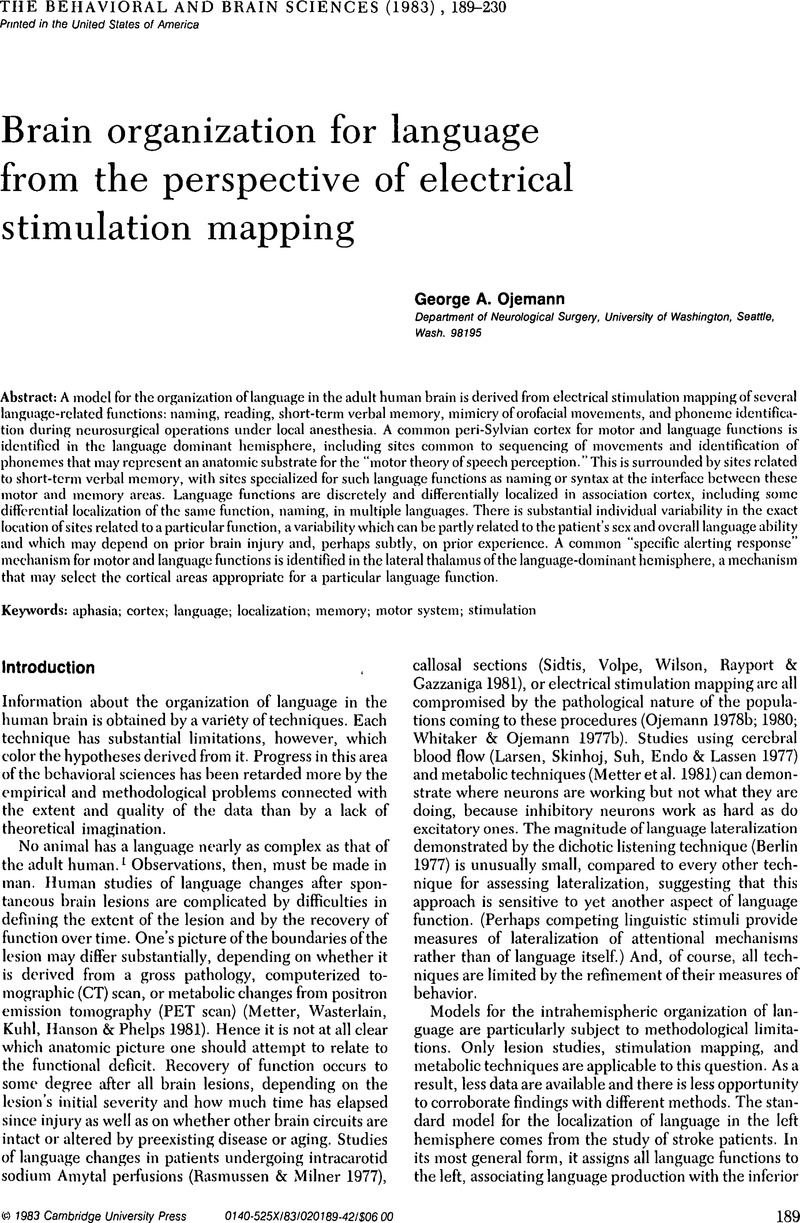Crossref Citations
This article has been cited by the following publications. This list is generated based on data provided by Crossref.
Ojemann, George A.
and
Dodrill, Carl B.
1985.
Verbal memory deficits after left temporal lobectomy for epilepsy.
Journal of Neurosurgery,
Vol. 62,
Issue. 1,
p.
101.
Ojemann, George A.
1987.
Duality and Unity of the Brain.
p.
283.
Ojemann, George A.
and
Creutzfeldt, Otto D.
1987.
Comprehensive Physiology.
p.
675.
Ojemann, George A.
1987.
Duality and Unity of the Brain.
p.
283.
Ojemann, George
Ojemann, Jeff
Lettich, E.
and
Berger, M.
1989.
Cortical language localization in left, dominant hemisphere.
Journal of Neurosurgery,
Vol. 71,
Issue. 3,
p.
316.
Matsuzawa, Tetsuro
1991.
Nesting cups and metatools in chimpanzees.
Behavioral and Brain Sciences,
Vol. 14,
Issue. 4,
p.
570.
Rolfe, Leonard
1991.
Hierarchical organization in grammar.
Behavioral and Brain Sciences,
Vol. 14,
Issue. 4,
p.
574.
Noble, William
and
Davidson, Iain
1991.
Evolving remembrance of times past and future.
Behavioral and Brain Sciences,
Vol. 14,
Issue. 4,
p.
572.
Powers, David M. W.
1991.
Goal directed behavior in the sensorimotor and language hierarchies.
Behavioral and Brain Sciences,
Vol. 14,
Issue. 4,
p.
572.
Grafman, Jordan
and
Hendler, James
1991.
Planning and the brain.
Behavioral and Brain Sciences,
Vol. 14,
Issue. 4,
p.
563.
Bickerton, Derek
1991.
Syntax is not as simple as it seems.
Behavioral and Brain Sciences,
Vol. 14,
Issue. 4,
p.
552.
Connolly, Kevin J.
and
Manoel, Edison de J.
1991.
Hierarchies and tool-using strategies.
Behavioral and Brain Sciences,
Vol. 14,
Issue. 4,
p.
554.
Greenfield, Patricia M.
1991.
Language, tools and brain: The ontogeny and phylogeny of hierarchically organized sequential behavior.
Behavioral and Brain Sciences,
Vol. 14,
Issue. 4,
p.
531.
Hauser, Marc D.
1991.
If you've got it, why not flaunt it? Monkeys with Broca's area but no syntactical structure to their vocal utterances.
Behavioral and Brain Sciences,
Vol. 14,
Issue. 4,
p.
564.
Thatcher, Robert W.
1991.
Are rhythms of human cerebral development “traveling waves”?.
Behavioral and Brain Sciences,
Vol. 14,
Issue. 4,
p.
575.
Ojemann, G. A.
1991.
Progress in Sensory Physiology.
Vol. 12,
Issue. ,
p.
193.
Fragaszy, Dorothy Munkenbeck
1991.
A comparative view of object combination and tool use: Moving ahead.
Behavioral and Brain Sciences,
Vol. 14,
Issue. 4,
p.
557.
Jacobs, Bob
1991.
Neurobiology and language acquisition: Continuity and identity.
Behavioral and Brain Sciences,
Vol. 14,
Issue. 4,
p.
565.
Lieberman, Philip
1991.
Speech and brain evolution.
Behavioral and Brain Sciences,
Vol. 14,
Issue. 4,
p.
566.
Tomasello, Michael
1991.
Objects are analogous to words, not phonemes or grammatical categories.
Behavioral and Brain Sciences,
Vol. 14,
Issue. 4,
p.
575.



